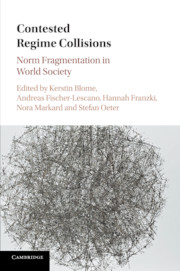Book contents
- Contested Regime Collisions
- Contested Regime Collisions
- Copyright page
- Contents
- Contributors
- Preface
- Contested collisions
- Part I Between collisions and interaction
- Part II Addressing collisions
- 5 Horizontal fundamental rights as conflict of laws rules
- 6 (Dis)Solving constitutional problems
- 7 Governance polycentrism or regulated self-regulation
- 8 Non-financial Reporting for business enterprises
- Part III Collisions otherwise
- Index
- References
6 - (Dis)Solving constitutional problems
Transconstitutionalism beyond collisions1
from Part II - Addressing collisions
Published online by Cambridge University Press: 05 May 2016
- Contested Regime Collisions
- Contested Regime Collisions
- Copyright page
- Contents
- Contributors
- Preface
- Contested collisions
- Part I Between collisions and interaction
- Part II Addressing collisions
- 5 Horizontal fundamental rights as conflict of laws rules
- 6 (Dis)Solving constitutional problems
- 7 Governance polycentrism or regulated self-regulation
- 8 Non-financial Reporting for business enterprises
- Part III Collisions otherwise
- Index
- References
- Type
- Chapter
- Information
- Contested Regime CollisionsNorm Fragmentation in World Society, pp. 169 - 197Publisher: Cambridge University PressPrint publication year: 2016
References
- 1
- Cited by

